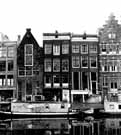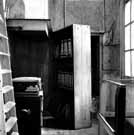
|
|
|

|

|

|

|
|
Click on an image to see a larger, more detailed picture.
|
|
|
|
|
| 1944: Desperate Acts |

|
pg. 548 |

|
|
|
|
| |
 This is the house at 263 Prinsengracht in which Anne Frank and her family hid for about two years. But in the end, an informer told local authorities about the Jews hiding in the house. On August 4, 1944, the SS and Security Police arrested the eight people concealed in the house's "secret annex." They also arrested two of the people who had been aiding them, Victor Kugler and Johannes Kleiman. Anne was transported to Auschwitz on September 3 and was eventually shipped to the camp at Bergen-Belsen, Germany. She died there in the early spring of 1945, just a few weeks before the British liberated the camp.
This is the house at 263 Prinsengracht in which Anne Frank and her family hid for about two years. But in the end, an informer told local authorities about the Jews hiding in the house. On August 4, 1944, the SS and Security Police arrested the eight people concealed in the house's "secret annex." They also arrested two of the people who had been aiding them, Victor Kugler and Johannes Kleiman. Anne was transported to Auschwitz on September 3 and was eventually shipped to the camp at Bergen-Belsen, Germany. She died there in the early spring of 1945, just a few weeks before the British liberated the camp.
Photo: Maria Austria Institute
|
 The staircase leading to Anne Frank's "secret annex" was hidden behind a bookcase. Hiding Jews from the Nazis was an extremely difficult, and dangerous, undertaking, and elaborate measures often had to be taken in order to assure successful concealment.
The staircase leading to Anne Frank's "secret annex" was hidden behind a bookcase. Hiding Jews from the Nazis was an extremely difficult, and dangerous, undertaking, and elaborate measures often had to be taken in order to assure successful concealment.
Photo: Maria Austria Institute / United States Holocaust Memorial Museum Photo Archive
|
 Anne Frank and the Jews of Holland
Anne Frank and the Jews of Holland
Of the 140,000 Jews living in Holland when that country fell to the Nazis in May 1940, 75 percent ultimately perished. Only about 5200 of the more than 100,000 deported to the East survived the war. The Jewish population of Holland also included more than 14,000 Jews from Germany who, in trying to escape the Nazis, had fled across the border. Among them was 11-year-old Anne Frank and her family, living in Amsterdam. The Franks, who had left Germany in 1933, suddenly found themselves trapped with the Nazi takeover of Holland. When roundups and deportations began in 1942, the Franks went into hiding. For two years Anne and her sister, mother, and father lived secretly in a tiny attic space they shared with four others. They relied on non-Jewish friends, who risked their own safety to supply them with food. In a diary she received for her 13th birthday, Anne recorded the emotions, fears, and daily difficulties of the group's harrowing existence. In August 1944, however, an anonymous informant revealed their location to the police. The SS arrested all eight Jews and transported them to the Westerbork transit camp; from there the prisoners were shipped to Auschwitz. Anne's mother, Edith, perished at Auschwitz in January 1945. After contracting typhus, Anne and her sister, Margot, died at Bergen-Belsen in March 1945. Her father, Otto, survived, and later published Anne's remarkable and now famous diary.
Photo: Anne Frank Stichting / United States Holocaust Memorial Museum Photo Archive
|
|

|

|

|

|
 August 1, 1944: The Red Army liberates Kovno, Lithuania. During the liberation, non-Jewish residents murder local carpenter Jan Pauvlavicius for having shielded Jews three weeks earlier.
August 1, 1944: The Red Army liberates Kovno, Lithuania. During the liberation, non-Jewish residents murder local carpenter Jan Pauvlavicius for having shielded Jews three weeks earlier.
|
 August 1, 1944: In Pisa, Italy, Catholic philanthropist Giuseppe Pardo Roques, four gentiles, and seven Jews he had sheltered are murdered by Nazis.
August 1, 1944: In Pisa, Italy, Catholic philanthropist Giuseppe Pardo Roques, four gentiles, and seven Jews he had sheltered are murdered by Nazis.
|
 August 1-October 4, 1944: The Polish underground and 1000 Jews revolt against the Germans in Warsaw. The New York Times carries long stories on this uprising almost every day, several of them on the front page. The Allies make great efforts to assist the Poles, even when the Allies know that to fly war materiel into Warsaw will result in heavy air losses and in German seizure of most of the materiel that lands. About 100 bombers are diverted from other war action for two months, interrupting the Allied strategic bombing campaign against Germany.
August 1-October 4, 1944: The Polish underground and 1000 Jews revolt against the Germans in Warsaw. The New York Times carries long stories on this uprising almost every day, several of them on the front page. The Allies make great efforts to assist the Poles, even when the Allies know that to fly war materiel into Warsaw will result in heavy air losses and in German seizure of most of the materiel that lands. About 100 bombers are diverted from other war action for two months, interrupting the Allied strategic bombing campaign against Germany.
|
|
|
|
|
| 1944: Desperate Acts |

|
pg. 548 |

|
|
The Holocaust Chronicle
© 2009 Publications International, Ltd.
|
|
